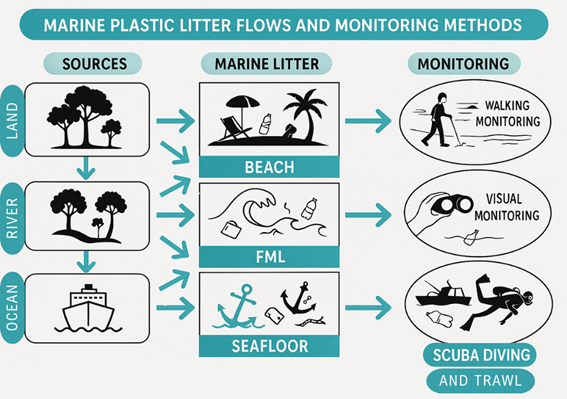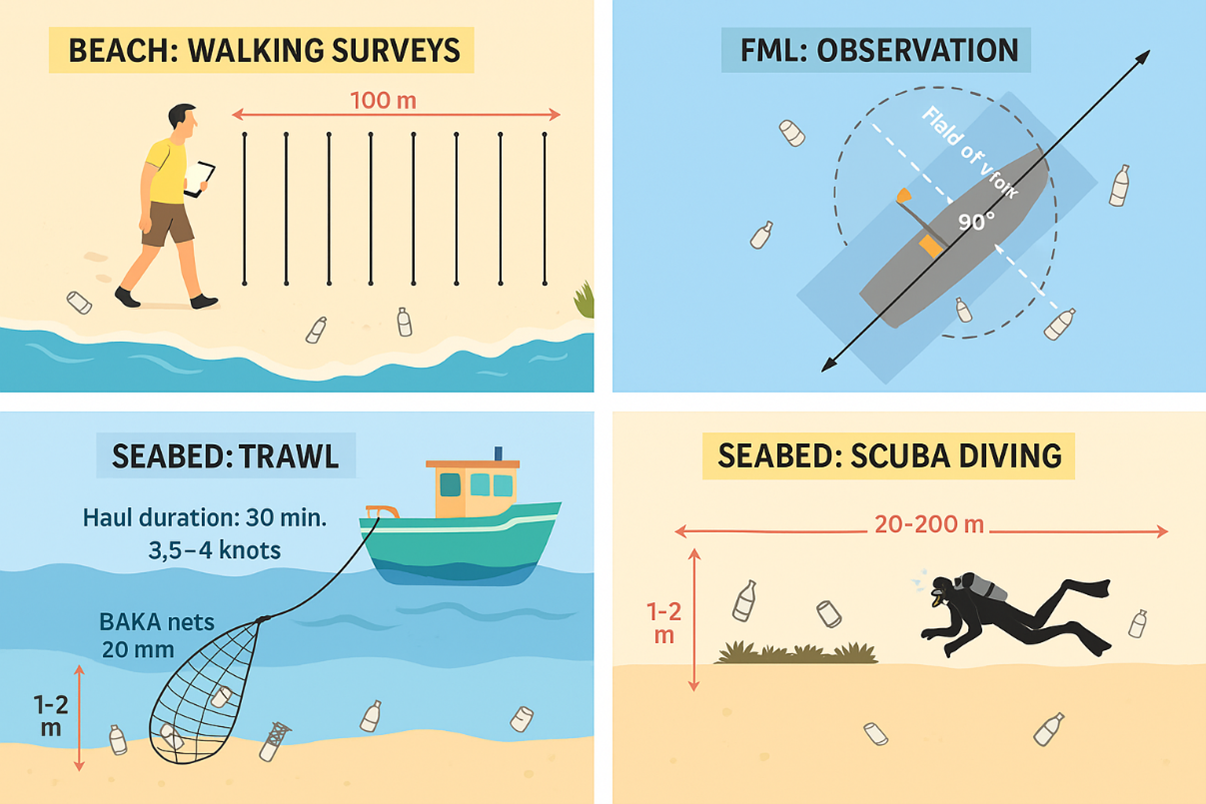Marine litter threats the Bay of Biscay
Authors: Carlota Alfaro-Ortega, Life Cycle Thinking Group UPV/EHU, Julen Ibarretxe, Department of Applied Physics UPV/EHU, Maider Iturrondobeitia, Department of Graphic Design and Engineering Projects UPV/EHU.
In 2023, over 310 million tons of plastics were produced globally, and this volume is projected to reach 710 million tons by 2040 1. This extensive use, at the domestic, tourism, industrial, and fishing levels, combined with inadequate waste management, has led to the rapid accumulation of plastics in our environment, making them a widespread pollutant in the ocean.
Plastic pollution originates from both land-based and ocean-based sources. Land-based sources contribute about 80% of plastic litter and include beaches, freshwater inputs, domestic activities, tourism, harbour operations, and even landfills. The remaining plastics come from marine activities such as merchant shipping, fishing vessels or aquaculture. The litter produced by these activities can accumulate on beaches, float in the sea or settle on the bottom (with 70% sinking to the bottom 2) in both coastal and deep-sea areas depending on object type, composition, density and hydrodynamic behaviour 3.

Monitoring methods
There are various systems for marine litter monitoring, based on three main sites: beaches, ocean surface, and seafloor 4. Beach macro litter is the principal focus due to its accessibility and straightforward monitoring techniques, involving both scientific communities and citizen science initiatives. A 100-metre stretch from the shoreline to the end of the beach should be covered, with several sections selected at random. On the other hand, floating marine litter can be monitored through human observation, net trawls, multispectral and hyperspectral imagery, video with intelligent algorithms, and GPS tags. The simplest method is visual observation from various platforms such as ships, boats, and aircraft.

Quantifying seafloor litter is challenging due to technical difficulties: monitoring methods include trawl surveys, diving, and imagery-based techniques. Trawl surveys, common in deep waters, impact benthic ecosystems and are often conducted during fish stock expeditions. Diving surveys, on the contrary, are used in shallow waters, and generally involve citizen scientists and cover areas inaccessible to trawls. The divers create a transect with a rope, along which divers search for litter within 1 to 2 meters on both sides of the rope.
The case of the Bay of Biscay
CIRSEPLAS, a recent study backed by the Department of Sustainability of the Diputación Foral de Gipuzkoa, has examined the current pollution state of the Bay of Biscay. This region is a semi-enclosed sea, distinguished by its unique physical oceanography and significant human activities related to marine resources and tourism. The area has been identified as a marine litter accumulation zone, with litter densities comparable to those in enclosed seas like the Mediterranean Sea. Litter concentrations range from 315.800 items/km² on beaches to 3,13 items/km² on the surface and 4.813 items/km² in the canyons, with plastic being the predominant category, accounting for as much as 96,7% of the total waste.
The density of beach, floating, and seabed litter shows significant seasonal variability. High concentrations of beach litter in winter may be attributed to prevailing south-westerly winds, which create a predominant eastward flow along the Bay. However, there is no consensus among researchers regarding the seasonality of floating marine litter and seabed litter. The high population density in coastal areas and the influence of French rivers, which have greater flows than Spanish rivers, contribute to increased litter accumulation, particularly in France. In fact, a black spot in litter accumulation has been identified near the mouth of the Adour River (France), where its moderate flow rate does not allow debris to be transported out into the open sea, creating a litter accumulation zone for beaches (La Barre: 1.101 units/100m), floating marine litter, and the seabed 5.
Additionally, the Bay of Biscay accumulates floating debris, particularly within the first few nautical miles from the coast, with sea-based sources accounting for 35% of the floating debris. In contrast, the highest average concentration of seabed litter was found in the canyons of the Bay of Biscay, with an average of 4.813 items/km². This is an order of magnitude higher than the highest densities reported from the continental shelf, confirming that canyons along continental margins act as sinks for marine litter.
The importance of harmonization
Despite the wealth of data collected on marine litter, combining these datasets remains a significant challenge. This difficulty arises from the diverse methods, classifications, databases, and result formats used in monitoring. To draw concrete conclusions, methodological harmonization is essential. To address these discrepancies, establishing a collaborative research network involving both Spanish and French research groups is highly recommended. This network would ensure the consistent application of methodologies, classifications, and databases. Additionally, it would designate specific monitoring locations to cover the area uniformly each season. The network should prioritize the study of seabed litter, which is more prevalent than floating litter. While beaches already receive considerable attention, a focused effort on seabed litter is crucial for a comprehensive understanding of marine litter accumulation. Adopting a unified approach will help obtain globally comparable results and uncover the true extent of marine litter accumulation in the Bay of Biscay. Additionally, it will provide a deeper understanding of the factors influencing its distribution.
References
- Canals, M., Pham, C., Bergmann, M., Gutow, L., Hanke, G., van Sebille, E., Angiolillo, M., Buhl-Mortensen, L., Cau, A., Ioakeimidis, C., Kammann, U., Lundsten, L., et al. (2021). The quest for seafloor macro litter: A critical review of background knowledge, current methods and future prospects, Env. Res. Lett. doi: 0.1088/1748-9326/abc6d4 ↩
- Cheshire, A.C., Adler, E., Barbière, J., Cohen, Y., Evans, S., Jarayabhand, S., Jeftic, L., Jung, R.T., Kinsey, S., Kusui, E.T., Lavine, I., Manyara, P., Oosterbaan, L., Pereira, M.A., Sheavly, S., Tkalin, A., Varadarajan, S., Wenneker, B., Westphalen, G. (2009). UNEP/IOC Guidelines on Survey and Monitoring of Marine Litter. Nairobi, Kenya, United Nations Environment Programme. (UNEP Regional Seas Reports and Studies, No. 186; IOC Technical Series No. 83). DOI: 10.25607/OBP-726 ↩
- MSFD Technical Group on Marine Litter (2023) Guidance on the monitoring of marine litter in European seas – An update to improve the harmonised monitoring of marine litter under the Marine Strategy Framework Directive Publications Office of the European Union https://data.europa.eu/doi/10.2760/59137 ↩
- Global Plastic Production. (2023). Statista. Annual production of plastics worldwide from 1950 to 2023. (Accessed date: November 2024). ↩
- UNEP (2005). Marine Litter, an Analytical Overview United Nations Environment Programme ↩